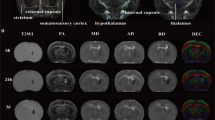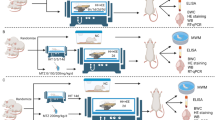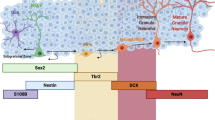Abstract
Exposure to intermittent hypoxia (IH), such as occurs in sleep-disordered breathing, is associated with increased apoptosis in vulnerable brain regions as well as with spatial reference memory deficits in adult and developing rats. The latter are more susceptible to IH, suggesting that early exposure to IH may have long-term consequences. Rats were exposed to 14 d of room air (RA) or IH starting at postnatal d 10. Working memory was then assessed in the water maze at 4 mo of age using a delayed matching to place task in which the rats were required to locate a submerged platform hidden in a novel location on the first trial (T1 or acquisition trial), and then remember that position after a delay (T2 or test trial). Mean escape latencies and swim distances were derived and the savings (T1–T2) were used as a measure of working memory. Male but not female rats exposed to IH showed working memory deficits at both a 10- and 120-min delay (for both latency and pathlength). Additionally, Sholl analysis of Golgi-stained neurons revealed decreased dendritic branching in the frontal cortex, but not the hippocampus, of male rats exposed to IH. Norepinephrine concentrations, dopamine turnover, and tyrosine hydroxylase activity were increased similarly in males and females. However, increased dopamine concentrations were present only in the frontal cortex of female rats. In conclusion, exposure to IH during a critical developmental period is associated with long-term alterations in frontal cortical dopaminergic pathways that may underlie gender differences in neurobehavioral deficits.
Similar content being viewed by others
Log in or create a free account to read this content
Gain free access to this article, as well as selected content from this journal and more on nature.com
or
Abbreviations
- Cx:
-
somatic cortex
- DA:
-
dopamine
- IH:
-
intermittent hypoxia
- OSA:
-
obstructive sleep apnea
- PFC:
-
pre-frontal cortex
- RA:
-
room air
- TH:
-
tyrosine hydroxylase
References
Partinen M, Telakivi T 1992 Epidemiology of obstructive sleep apnea syndrome. Sleep 15: S1–S4
Redline S, Young T 1993 Epidemiology and natural history of obstructive sleep apnea. Ear Nose Throat J 72: 20–26
Young T, Peppard PE, Gottlieb DJ 2002 Epidemiology of obstructive sleep apnea: a population health perspective. Am J Respir Crit Care Med 165: 1217–1239
Kales A, Caldwell AB, Cadieux RJ, Vela-Bueno A, Ruch LG, Mayes SD 1985 Severe obstructive sleep apnea–II: Associated psychopathology and psychosocial consequences. J Chronic Dis 38: 427–434
Bedard MA, Montplaisir J, Richer F, Rouleau I, Malo J 1991 Obstructive sleep apnea syndrome: pathogenesis of neuropsychological deficits. J Clin Exp Neuropsychol 13: 950–964
Gozal D 2001 Morbidity of obstructive sleep apnea in children: facts and theory. Sleep Breath 5: 35–42
Beebe DW, Gozal D 2002 Obstructive sleep apnea and the prefrontal cortex: towards a comprehensive model linking nocturnal upper airway obstruction to daytime cognitive and behavioral deficits. J Sleep Res 11: 1–16
Gozal D, Daniel JM, Dohanich GP 2001 Behavioral and anatomical correlates of chronic episodic hypoxia during sleep in the rat. J Neurosci 21: 2442–2450
Row BW, Kheirandish L, Neville JJ, Gozal D 2002 Impaired spatial learning and hyperactivity in developing rats exposed to intermittent hypoxia. Pediatr Res 52: 449–453
Goldbart A, Cheng ZJ, Brittian KR, Gozal D 2003 Intermittent hypoxia induces time-dependent changes in the protein kinase B signaling pathway in the hippocampal CA1 region of the rat. Neurobiol Dis 14: 440–446
Goldbart A, Row BW, Kheirandish L, Schurr A, Gozal E, Guo SZ, Payne RS, Cheng Z, Brittian KR, Gozal D 2003 Intermittent hypoxic exposure during light phase induces changes in cAMP response element binding protein activity in the rat CA1 hippocampal region: water maze performance correlates. Neuroscience 122: 585–590
Gozal D, Reeves SR, Row BW, Neville JJ, Guo SZ, Lipton AJ 2003 Respiratory effects of gestational intermittent hypoxia in the developing rat. Am J Respir Crit Care Med 167: 1540–1547
Gozal D, Row BW, Gozal E, Kheirandish L, Neville JJ, Brittian KR, Sachleben LR Jr, Guo SZ 2003 Temporal aspects of spatial task performance during intermittent hypoxia in the rat: evidence for neurogenesis. Eur J Neurosci 18: 2335–2342
Gozal D, Row BW, Kheirandish L, Liu R, Guo SZ, Qiang F, Brittian KR 2003 Increased susceptibility to intermittent hypoxia in aging rats: changes in proteasomal activity, neuronal apoptosis and spatial function. J Neurochem 86: 1545–1552
Li RC, Row BW, Gozal E, Kheirandish L, Fan Q, Brittian KR, Guo SZ, Sachleben LR Jr, Gozal D 2003 Cyclooxygenase 2 and intermittent hypoxia-induced spatial deficits in the rat. Am J Respir Crit Care Med 168: 469–475
Row BW, Goldbart A, Gozal E, Gozal D 2003 Spatial pre-training attenuates hippocampal impairments in rats exposed to intermittent hypoxia. Neurosci Lett 339: 67–71
Row BW, Liu R, Xu W, Kheirandish L, Gozal D 2003 Intermittent hypoxia is associated with oxidative stress and spatial learning deficits in the rat. Am J Respir Crit Care Med 167: 1548–1553
Gozal E, Row BW, Schurr A, Gozal D 2001 Developmental differences in cortical and hippocampal vulnerability to intermittent hypoxia in the rat. Neurosci Lett 305: 197–201
Decker MJ, Hue GE, Caudle WM, Miller GW, Keating GL, Rye DB 2003 Episodic neonatal hypoxia evokes executive dysfunction and regionally specific alterations in markers of dopamine signaling. Neuroscience 117: 417–425
Hodges H 1996 Maze procedures: the radial-arm and water maze compared. Brain Res Cogn Brain Res 3: 167–181
Steele RJ, Morris RG 1999 Delay-dependent impairment of a matching-to-place task with chronic and intrahippocampal infusion of the NMDA-antagonist D-AP5. Hippocampus 9: 118–136
Mamet J, Peyronnet J, Roux JC, Perrin D, Cottet-Emard JM, Pequignot JM, Lagercrantz H, Dalmaz Y 2002 Long-term prenatal hypoxia alters maturation of adrenal medulla in rat. Pediatr Res 51: 207–214
Soulage C, Perrin D, Cottet-Emard JM, Pequignot J, Dalmaz Y, Pequignot JM 2004 Central and peripheral changes in catecholamine biosynthesis and turnover in rats after a short period of ozone exposure. Neurochem Int 45: 979–986
Pepin JL, Levy P, Garcin A, Feuerstein C, Savasta M 1996 Effects of long-term hypoxia on tyrosine hydroxylase protein content in catecholaminergic rat brainstem areas: a quantitative autoradiographic study. Brain Res 733: 1–8
Roux JC, Pequignot JM, Dumas S, Pascual O, Ghilini G, Pequignot J, Mallet J, Denavit-Saubie M 2000 O2-sensing after carotid chemodenervation: hypoxic ventilatory responsiveness and upregulation of tyrosine hydroxylase mRNA in brainstem catecholaminergic cells. Eur J Neurosci 12: 3181–3190
Valverde F 1976 Aspects of cortical organization related to the geometry of neurons with intra-cortical axons. J Neurocytol 5: 509–529
Sholl DA 1953 Dendritic organization in the neurons of the visual and motor cortices of the cat. J Anat 87: 387–406
Simons JS, Spiers HJ 2003 Prefrontal and medial temporal lobe interactions in long-term memory. Nat Rev Neurosci 4: 637–648
Grojean S, Schroeder H, Pourie G, Charriaut-Marlangue C, Koziel V, Desor D, Vert P, Daval JL 2003 Histopathological alterations and functional brain deficits after transient hypoxia in the newborn rat pup: a long term follow-up. Neurobiol Dis 14: 265–278
Simonova Z, Sterbova K, Brozek G, Komarek V, Sykova E 2003 Postnatal hypobaric hypoxia in rats impairs water maze learning and the morphology of neurones and macroglia in cortex and hippocampus. Behav Brain Res 141: 195–205
Nyakas C, Markel E, Schuurman T, Luiten PG 1991 Impaired learning and abnormal open-field behaviours of rats after early postnatal anoxia and the beneficial effect of the calcium antagonist nimodipine. Eur J Neurosci 3: 168–174
Hermans RH, Hunter DE, McGivern RF, Cain CD, Longo LD 1992 Behavioral sequelae in young rats of acute intermittent antenatal hypoxia. Neurotoxicol Teratol 14: 119–129
Nyakas C, Buwalda B, Kramers RJ, Traber J, Luiten PG 1994 Postnatal development of hippocampal and neocortical cholinergic and serotonergic innervation in rat: effects of nitrite-induced prenatal hypoxia and nimodipine treatment. Neuroscience 59: 541–559
Nyakas C, Buwalda B, Luiten PG 1996 Hypoxia and brain development. Prog Neurobiol 49: 1–51
Becker JB Gender differences in dopaminergic function in striatum and nucleus accumbens. Pharmacol Biochem Behav 64: 803–812
Andersen SL, Teicher MH 2000 Sex differences in dopamine receptors and their relevance to ADHD. Neurosci Biobehav Rev 24: 137–141
Markham JA, Juraska JM 2002 Aging and sex influence the anatomy of the rat anterior cingulate cortex. Neurobiol Aging 23: 579–588
Stone DJ, Rozovsky I, Morgan TE, Anderson CP, Lopez LM, Shick J, Finch CE 2000 Effects of age on gene expression during estrogen-induced synaptic sprouting in the female rat. Exp Neurol 165: 46–57
Kellogg CK, Primus RJ, Bitran D 1991 Sexually dimorphic influence of prenatal exposure to diazepam on behavioral responses to environmental challenge and on gamma-aminobutyric acid (GABA)-stimulated chloride uptake in the brain. J Pharmacol Exp Ther 256: 259–265
Gozal D, Pope DW Jr 2001 Snoring during early childhood and academic performance at ages thirteen to fourteen years. Pediatrics 107: 1394–1399
Author information
Authors and Affiliations
Corresponding author
Additional information
Supported by National Institutes of Health grants HL69932, HL63912, and P50 HL60296 (D.G.) and HD42395 (B.W.R.), and The Commonwealth of Kentucky Research Challenge Trust Fund.
Rights and permissions
About this article
Cite this article
Kheirandish, L., Gozal, D., Pequignot, JM. et al. Intermittent Hypoxia during Development Induces Long-Term Alterations in Spatial Working Memory, Monoamines, and Dendritic Branching in Rat Frontal Cortex. Pediatr Res 58, 594–599 (2005). https://doi.org/10.1203/01.pdr.0000176915.19287.e2
Received:
Accepted:
Issue date:
DOI: https://doi.org/10.1203/01.pdr.0000176915.19287.e2
This article is cited by
-
Effects of exercise training on brain metabolism and cognitive functioning in sleep apnea
Scientific Reports (2022)
-
Metoprolol prevents neuronal dendrite remodeling in a canine model of chronic obstructive sleep apnea
Acta Pharmacologica Sinica (2020)
-
Hypercapnia impaired cognitive and memory functions in obese patients with obstructive sleep apnoea
Scientific Reports (2018)
-
Exosomes, blood–brain barrier, and cognitive dysfunction in pediatric sleep apnea
Sleep and Biological Rhythms (2017)
-
Correlation between hippocampal sulcus width and severity of obstructive sleep apnea syndrome
European Archives of Oto-Rhino-Laryngology (2015)



